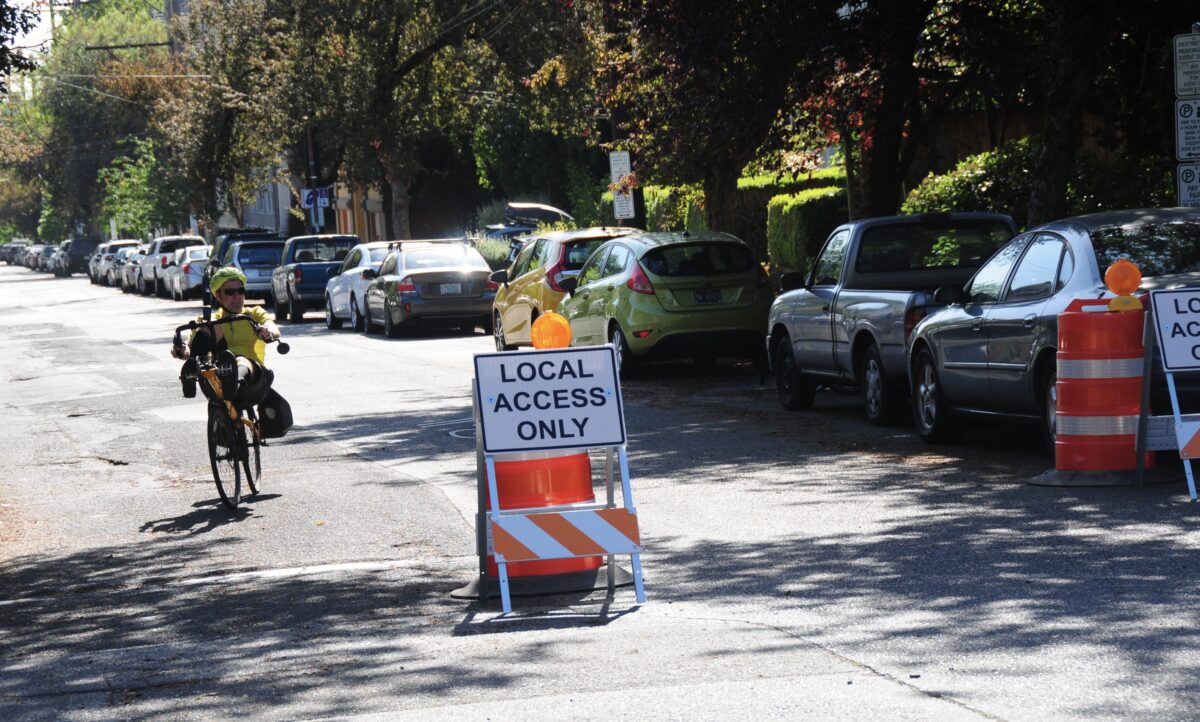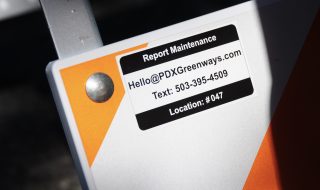
(Photos: J. Maus/BikePortland)

By the end of tomorrow, 100 sets of signs and barricades like the ones in the photo above will be standing in streets across Portland. This morning, a crew of private contractors working for the Portland Bureau of Transportation installed the temporary diverters on Northwest Flanders at 22nd.
At a press event to mark the occasion, PBOT Communications Director John Brady said their “Slow Streets Safe Streets” initiative is an effort to improve conditions on existing neighborhood greenways.
“Our [greenway] network has been working quite well, this is just an effort to make it safer,” he said. Brady also pointed out that, contrary to popular perception, no streets are being closed. “It’s really important to emphasize that we’re not closing the streets. We want to stop cut-through traffic,” he said. “If people need to get to a business, their homes, or if they have business on that street. Then they treat the street just like any other street.”
“It’s really important to emphasize that we’re not closing the streets.”
— John Brady, PBOT
This was good to hear and it relieved my concerns around some people’s misplaced freak-outs over “100 miles of streets closed to cars!”. This morning we watched several drivers of cars and even large trucks easily pass by the barricade.
Advertisement

Placement of the diverters is another key part of this effort. So far it looks good. There are three barricades for each installation. Two of them are backed by large orange reflective barrels. One set is placed in the middle of the street. The other two are set back a few feet, in the shadow of the parking lane near the curb.

You won’t see the barricades at the start of every block. PBOT has chosen strategic locations to create calmed corridors. This first installation at 22nd and Flanders for instance, was paired with another installation at 17th. So this is a five-block section.
As you can see in the images, the main sign in the middle of the street says, “Local Access Only”. Looks like PBOT has decided to place the green “Go Slow – Share the Street” next to the curb. I wonder if that’s a missed branding opportunity. Would have been stronger to place some sort of green campaign-specific sign on the main barricade to really emphasize what’s expected of people who enter the space.
To make help with maintenance and upkeep of the barriers, each one has a new sticker on it that says, “Report Maintenance” and includes an email, phone number and unique location number. This is super smart! It will also be useful not just for the contractor hired to maintain them, but also for volunteers who will watch over the barricades and keep them in good working order (nothing was said about this community volunteer effort today, but we expect to hear more about it soon).
Asked how long these treatments will be up, Brady said, “For the foreseeable future.” As for additional locations beyond the 100 already identified, Brady said they want to hear from the public and that a more formal outreach process will be announced shortly.
Advertisement
We haven’t seen a detailed set of criteria as to how PBOT is making location selections, but Brady shared a few more insights into that this morning. He said they’re looking at places in the greenway network that need enhancement. NW Flanders is one of the oldest greenways in the city and only has bare-bones treatments (like sharrows) to designate it as such. Brady also mentioned they’ve chosen locations based on factors like: a high volume of cut-through traffic, existence of multi-family housing, and places that are far away from public parks.
So far the effort is estimated to cost under $100,000 and PBOT is using existing funds. That comes to about $1,000 per location.
Bike Loud PDX volunteer RJ Shepherd was at the launch event this morning. He said PBOT has been “very responsive” to his group’s calls for more diversion on greenways going back several years now. “We’re very thankful the commissioner took this step forward,” he said. Shepherd wants PBOT to do more pilot projects similar to this one because they can be deployed quickly and cheaply. He also said Bike Loud will be pushing PBOT to stay the course: “We still think there’s more to do. There’s a long way to go.”
To some degree, PBOT agrees with Shepherd. They have already hinted at the next phase that could include “hardening” these temporary treatments into permanent diverters. Then there’s the parallel effort to create space on main streets. PBOT Commissioner Chloe Eudaly said on Facebook recently that her office is actively considering plans to allow cafes and restaurants to place tables in streets to create space for dining. Lots more to come indeed.
Keep your eyes peeled for these in your neighborhood. PBOT seemed confident this morning that all 100 installations would be completed by tomorrow.
— Jonathan Maus: (503) 706-8804, @jonathan_maus on Twitter and jonathan@bikeportland.org
— Get our headlines delivered to your inbox.
— Support this independent community media outlet with a one-time contribution or monthly subscription.

